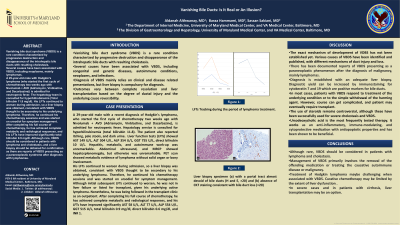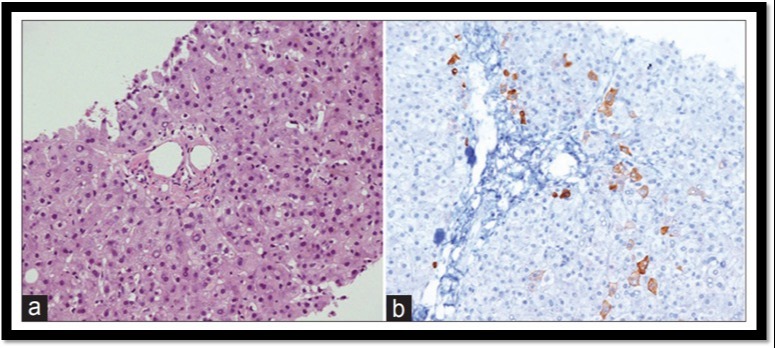Tuesday Poster Session
Category: Liver
P3924 - Vanishing Bile Ducts: Is It Real or an Illusion?
Tuesday, October 24, 2023
10:30 AM - 4:00 PM PT
Location: Exhibit Hall

Has Audio

Aldanah Althwanay, MD
University of Maryland Medical Center
Baltimore, MD
Presenting Author(s)
Aldanah Althwanay, MD, Baraa Hammami, MD, Sasan Sakiani, MD
University of Maryland Medical Center, Baltimore, MD
Introduction: Vanishing bile duct syndrome (VBDS) is a rare condition characterized by progressive destruction and disappearance of the intrahepatic bile ducts with resulting cholestasis.
Several causes have been associated with VBDS, including autoimmune conditions, infections, drug toxicities, and neoplasms. Outcomes vary between complete resolution and liver transplantation based on the degree of ductal injury and the underlying cause reversibility.
Case Description/Methods: A 29-year-old male with Hodgkin's lymphoma (who started the first cycle of chemotherapy two weeks ago with Nivolumab + AVD (Adriamycin, Vinblastine, and Dacarbazine)) is admitted for neutropenic fever. The hepatology team is consulted for hyperbilirubinemia (Total bilirubin 11.8 mg/dl). The patient reported itching, pale stools, and dark urine. LFTs at the time AST 149 U/L, ALT 304 U/L, ALP 354 U/L, GGT 755 U/L, direct bilirubin 10 mg/dl, and INR 1. Hepatitis, metabolic, and autoimmune work-up was unremarkable. Abdominal ultrasound and MRCP showed hepatosplenomegaly, but otherwise unremarkable. PET scan showed no evidence of solid organ or bony involvement. However, his LFTs continued to worsen during admission, so a liver biopsy was obtained, consistent with VBDS thought to be secondary to his underlying lymphoma. Therefore, he continued his chemotherapy sessions and was started on ursodiol for symptom management. Although initial subsequent LFTs continued to worsen, he was not in liver failure or listed for transplant, given his underlying active lymphoma.
Nonetheless, he was being followed in the transplant clinic as an outpatient. After completing his full course of chemotherapy, he has achieved complete metabolic and radiological responses, and his LFTs have improved significantly AST 58 U/L, ALT 77 U/L, ALP 554 U/L, GGT 515 U/L, total bilirubin 0.9 mg/dl, direct bilirubin 0.6 mg/dl, and INR 1.
Discussion: Although rare, VBDS should be considered in patients with lymphoma and cholestasis, and a liver biopsy should be obtained for confirmation as there are reports of VBDS presenting as a paraneoplastic syndrome after diagnosis with lymphomas. VBDS patients typically respond to treatment of the underlying condition. However, some patients may require a transplant. Ursodiol is the treatment of choice as it t works as an anti-inflammatory and cytoprotective medication.

Disclosures:
Aldanah Althwanay, MD, Baraa Hammami, MD, Sasan Sakiani, MD. P3924 - Vanishing Bile Ducts: Is It Real or an Illusion?, ACG 2023 Annual Scientific Meeting Abstracts. Vancouver, BC, Canada: American College of Gastroenterology.
University of Maryland Medical Center, Baltimore, MD
Introduction: Vanishing bile duct syndrome (VBDS) is a rare condition characterized by progressive destruction and disappearance of the intrahepatic bile ducts with resulting cholestasis.
Several causes have been associated with VBDS, including autoimmune conditions, infections, drug toxicities, and neoplasms. Outcomes vary between complete resolution and liver transplantation based on the degree of ductal injury and the underlying cause reversibility.
Case Description/Methods: A 29-year-old male with Hodgkin's lymphoma (who started the first cycle of chemotherapy two weeks ago with Nivolumab + AVD (Adriamycin, Vinblastine, and Dacarbazine)) is admitted for neutropenic fever. The hepatology team is consulted for hyperbilirubinemia (Total bilirubin 11.8 mg/dl). The patient reported itching, pale stools, and dark urine. LFTs at the time AST 149 U/L, ALT 304 U/L, ALP 354 U/L, GGT 755 U/L, direct bilirubin 10 mg/dl, and INR 1. Hepatitis, metabolic, and autoimmune work-up was unremarkable. Abdominal ultrasound and MRCP showed hepatosplenomegaly, but otherwise unremarkable. PET scan showed no evidence of solid organ or bony involvement. However, his LFTs continued to worsen during admission, so a liver biopsy was obtained, consistent with VBDS thought to be secondary to his underlying lymphoma. Therefore, he continued his chemotherapy sessions and was started on ursodiol for symptom management. Although initial subsequent LFTs continued to worsen, he was not in liver failure or listed for transplant, given his underlying active lymphoma.
Nonetheless, he was being followed in the transplant clinic as an outpatient. After completing his full course of chemotherapy, he has achieved complete metabolic and radiological responses, and his LFTs have improved significantly AST 58 U/L, ALT 77 U/L, ALP 554 U/L, GGT 515 U/L, total bilirubin 0.9 mg/dl, direct bilirubin 0.6 mg/dl, and INR 1.
Discussion: Although rare, VBDS should be considered in patients with lymphoma and cholestasis, and a liver biopsy should be obtained for confirmation as there are reports of VBDS presenting as a paraneoplastic syndrome after diagnosis with lymphomas. VBDS patients typically respond to treatment of the underlying condition. However, some patients may require a transplant. Ursodiol is the treatment of choice as it t works as an anti-inflammatory and cytoprotective medication.

Figure: Figure 1: Liver biopsy specimen (a) with a portal tract almost devoid of bile ducts (H and E, ×20) and (b) absence of CK7 staining consistent with bile duct loss (×20)
Disclosures:
Aldanah Althwanay indicated no relevant financial relationships.
Baraa Hammami indicated no relevant financial relationships.
Sasan Sakiani indicated no relevant financial relationships.
Aldanah Althwanay, MD, Baraa Hammami, MD, Sasan Sakiani, MD. P3924 - Vanishing Bile Ducts: Is It Real or an Illusion?, ACG 2023 Annual Scientific Meeting Abstracts. Vancouver, BC, Canada: American College of Gastroenterology.

